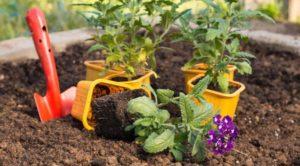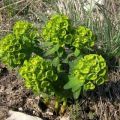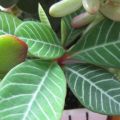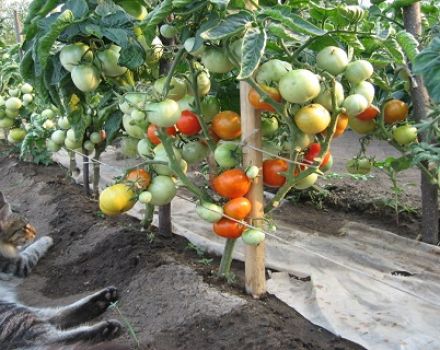Rules for planting and caring for triangular milkweed at home
Euphorbia triangular (triangular) is a plant that looks like a cactus. However, the spurge does not belong to the Cactus family, despite the fact that it has thorns. In the wild, the flower grows in Central America and Southwest Africa. Due to its decorative properties and unpretentious care, euphorbia has become widespread in cultural cultivation.
Brief characteristics and description of the flower
Euphorbia triangular or euphorbia trigone first appeared on the island of Madagascar. Belongs to the Euphorbia family. Euphorbia is a tall plant that reaches a height of two to three meters. The stems and branches have flattened ribs with long thorns, which is why many confuse it with a cactus. The plant is poisonous and a prick with thorns can cause intoxication. Milkweed leaves are small, drop-shaped in shape.
Why is spurge useful?
Milkweed preparations are used to treat wounds and cuts in the skin. Also in folk medicine, the plant is used for the manufacture of diuretics and laxatives. Its juices are able to cleanse the blood and slow down the growth of neoplasms, thanks to which the culture is used in the treatment of neoplasms. In official medicine, infusions from it are used to treat kidneys, hemorrhoids and eczema.
How to create ideal conditions for culture maintenance
Like any house plant, euphorbia needs the right conditions for its development. The flower must be provided with sufficient lighting, suitable soil, temperature and humidity in the room..
Lighting and location
Euphorbia is a light-loving plant, therefore bright lighting is necessary for its development. Choose a place for planting that is as illuminated as possible by the sun. In summer, it is better to rearrange the pot on the balcony.
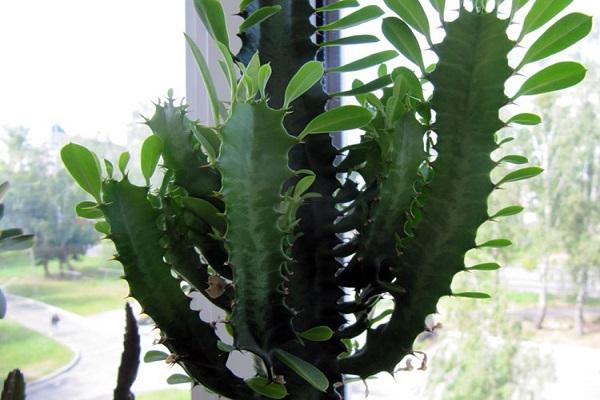
Required soil composition
For milkweed, a loose soil that allows water to pass through is suitable. You can purchase the appropriate primer at the store or make it yourself. To do this, you need to mix peat, sand, leafy and sod land in equal proportions. In addition, the plant needs a drainage layer. It can be made from small pebbles or bricks.
Selection of a flower pot
A clay pot is best suited for this plant.It should be deep and have drainage holes. Choose an appropriately sized pot so that the stem does not outweigh it or fall over. It makes sense to immediately put a strong high pole in the pot and tie the stem to it as it grows.
Temperature regime by seasons
Euphorbia is a heat-loving flower. It tolerates temperature changes quite steadily, but drafts can harm it. In the summer season, milkweed should be kept at a temperature of 20-25 degrees Celsius. In winter, euphorbia feels better at an average temperature of 14 degrees. This mode allows inflorescences to be laid. However, you should not lower the temperature below plus ten degrees.
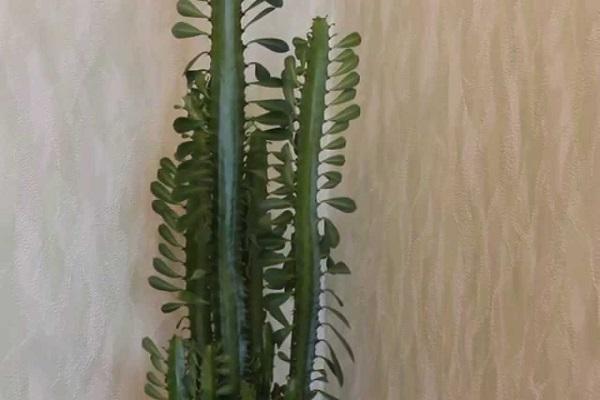
Room humidity
In terms of air humidity, Euphorbia is quite unpretentious, but it will not be superfluous to regularly spray the leaves and stems with the help of a shower. In this case, do not forget to cover the soil with a film during water procedures, so as not to overflow the soil.
You bought a flower - and what next?
After planting, the plant needs proper care. Despite the fact that euphorbia is unpretentious in terms of care, it must be repotted regularly, watered in the correct way and applied the necessary fertilizers to the soil.
How often should the plant be watered
The flower does not need frequent abundant watering. It copes much more easily with a lack of moisture than with an excess of it. In the warm season, the flower should be watered once a week, and in winter - once a month. Watering should be done very carefully, since the thorns of the plant contain sap, which can cause intoxication of the body.
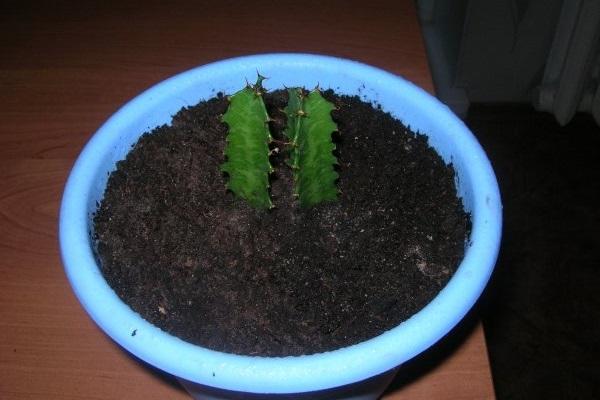
Fertilization
Fertilizers are recommended to be applied to the soil from spring to autumn. Compound fertilizers for succulents, which can be bought in specialized stores, are suitable. These complexes contain all the necessary substances that have a beneficial effect on flower development.
Frequency of transfers
The flower should be transplanted no more than once every two years. The transplant should be carried out as needed, to replace the pot with a larger one. The transplant procedure should be carried out in early spring, when the shoots have not yet begun to grow intensively.
Formative pruning of milkweed
Unlike the varieties of milkweed that grow in a bush, the triangular milkweed does not need sanitary pruning. Weak shoots and leaves of the flower do not need to be cut, they dry up and fall off on their own. However, the triangular spurge is very branching, so formative pruning should be carried out annually so that the plant does not look like a large, branched tree.
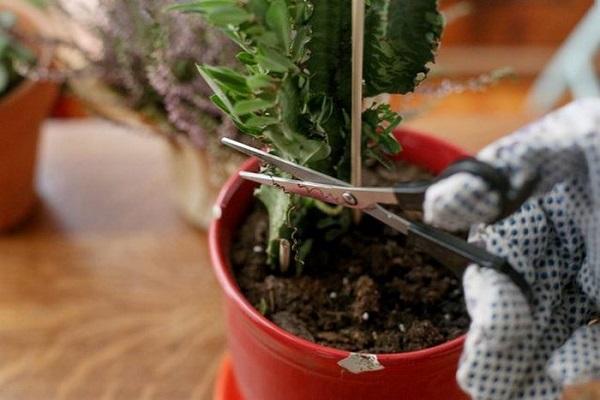
What diseases and pests the culture is susceptible to: control methods
If the plant is not properly cared for, it can get sick. In case of insufficient or excessive feeding, the leaves of milkweed may turn yellow. Due to excess moisture due to excessive watering and lack of drainage, the flower may fall off leaves. Also, due to excessive watering, the plant's root system rots.
Due to the scorching rays of the sun, brown growths often appear on the stems of the plant, with the help of which the euphorbia protects itself from too high temperatures. The growths do not need treatment, but their presence negatively affects the appearance of the plant.
The pests to which the culture is exposed are aphids, mites and mealybugs. To combat them, insecticide preparations should be used.
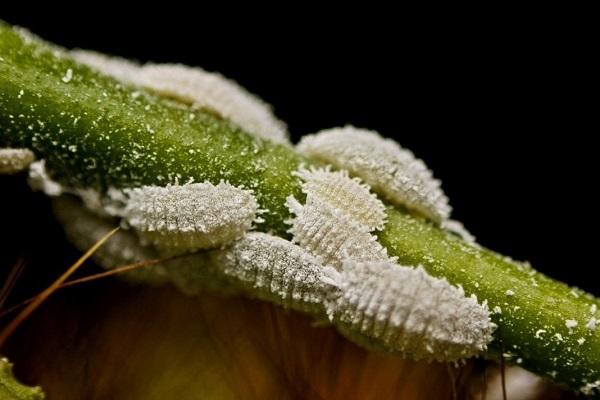
Reproduction methods
The main breeding method for triangular milkweed is cuttings. The advantages of this method are that it is cost effective and highly efficient. Moreover, if you follow all the rules of reproduction, there will be a minimum number of dead seedlings.In order to propagate the plant by cuttings, it is necessary to carefully cut off young healthy cuttings with a sharp knife, and treat the remaining wound with coal.
The cut shoots should be left for a couple of days in a dry, warm place, after which the young plant should be planted in prepared soil, and the pot should be placed in a warm, lighted place.
In addition to cuttings, a seed propagation method is available. However, this method is characterized by poor germination and long germination. Seeds should be purchased from trusted sellers and planted fresh in the ground. If it is impossible to plant them fresh, the seeds should be stored in a dry place, however, it should be borne in mind that the germination of seed material will decrease.
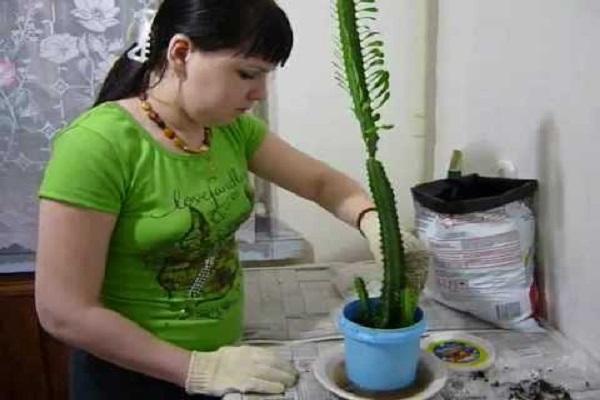
Problems of growing an African flower
Since the plant is unpretentious in terms of care, there are quite few problems with its cultivation. However, there are some negative points that a florist can face. Brown rot spots may appear on the stem and leaves of the plant as a reaction to over-watering. Due to insufficient illumination, the stalks of the milkweed can stretch out, this is especially noticeable in winter. In addition, in a pot that is too spacious, the plant grows rather quickly due to the increase in roots.
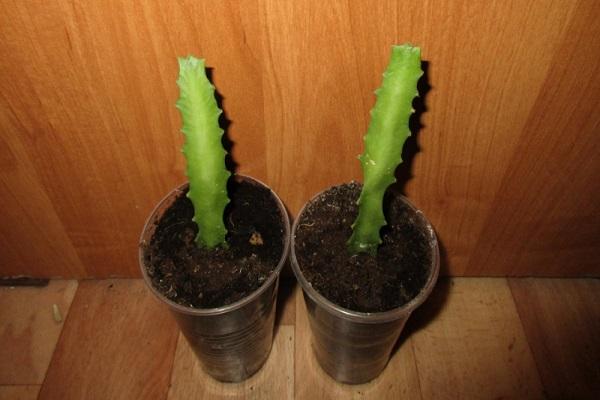
Signs associated with triangular milkweed
According to legend, the triangular spurge has life-giving power and is able to bring peace to the house in which it grows. Popular signs attribute to him the ability to give peace, moral and physical relaxation, as well as to positively influence the human musculoskeletal system.
However, like any plant with thorns, it should not be placed in the bedroom. This is especially true for married couples, as this can contribute to conflicts between loved ones..

